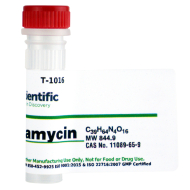When we hear the terms cell death and endoplasmic reticulum (ER) stress, what first comes to mind? Stress? Death? Two concepts that don’t exactly inspire positive thoughts. However, in the case of the antibiotic compound tunicamycin, cell death and ER stress are the objectives!
What is Tunicamycin?
Tunicamycin is an antibiotic isolated from Streptomyces lysosuperificus and is incredibly important for research involving glycoproteins.Tunicamycin is supplied as a white, dissolvable crystalline powder. It acts by inhibiting the process of N-linked glycosylation. This is a property of tunicamycin that is used in research on viruses and diseases involving abnormally folded proteins.
Glycosylation Process
Protein and carbohydrates are two macronutrients found in cells. Glycosylation occurs in the endoplasmic reticulum (ER) when a protein enters the second stage of transformation when attaching to a carbohydrate molecule. N-linked glycosylation simply means that the nitrogen atom in tunicamycin is attached to the sugar, or carbohydrate. The newly formed molecule is called a glycoprotein. Unfortunately, proteins sometimes “fold” abnormally during their formation. This causes mutant protein chains. Neurodegenerative disorders such as Parkinson’s, Alzheimer’s disease, and certain types of cancer all share this in common: misfolded proteins.Misfolded Proteins
Proteins have vitally important functions in each cell - when structured correctly. Unfortunately this does not always happen. A single protein molecule is composed of approximately 300 amino acids, and there are many different types. The types of amino acids present determine the shape and function of the protein molecule.
This folding is essential for the protein to perform its job correctly, so as you can imagine, any misfolding can prohibit the protein from being effective. It can mutate the protein and therefore activate types of disorders and diseases within the cell. Many disorders share misfolded proteins in common as a root cause.
Inducing ER Stress and Cell Death
The endoplasmic reticulum (ER) is the premier site of protein synthesis within cells. The ER is ultra-sensitive to differences between folded and misfolded “mutant” proteins. This means when a protein is misfolded, often it will trigger what is called an ER stress response in the cell.
When the ER is stressed out from not being able to process proteins efficiently due to misfolding, cells panic and try to calm it down by way of the Unfolding Protein Response (UPR). This is the collective term for all the processes ER stress causes the cell to create. Cells then either adapt to the changes elicited by the ER stress response or die - celll death occurs.
Ideally, this process of ER stress, cell death, and UPR would return the cell to homeostasis, however, that is not always the case. Through studying the pathways of response to mutant & misfolded proteins, researchers hope to find treatments and even cures for many neurodegenerative disorders, and produce more effective treatments for cancers.
Tunicamycin ER Stress Mechanism
In order to study ER stress responses and cell death rates, scientists must first be able to induce it and capture the process, meaning a reagent must be introduced to the cell. Scientists use many different methods for inducing and studying ER stress, but tunicamycin is very useful for such studies. When tunicamycin is introduced to a cell, it interferes with the protein folding at the source - the ER lumen. This creates misfolded proteins which in turn induce ER stress, weeding out resistant cells unable to adapt via cell death.
With therapeutic remedies as the main focus of utilizing tunicamycin, promising results come from experimentation. Where cancer cells are resistant to other treatments, new research is being done on tunicamycin-induced stress responses to potentially bypass such resistance.

While we may be far off from cures, chemical substances like tunicamycin are providing structure for research on cell death and ridding organisms of diseased cells with misfolded proteins.
